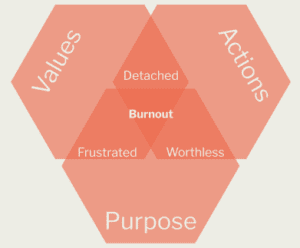
Unpacking Unarmoured Leadership: A how-to for vulnerability at work
Many of us in the leadership and management space (whether working in leadership development, being leaders or just paying attention to how we are being led), will have noticed the recent uptick in talk of unarmoured leadership and being vulnerable at work…and we are, perhaps surprisingly, talking about these as positive things. At The Hive, we are pretty excited about this.
It’s easy to see this addition to the leadership lexicon as an extension of the ‘authenticity at work’ trend of the 2010s. As the concept of authenticity caught traction in the late 2000s and early 2010s, the idea was regularly presented as something we should be aiming for. Just as regularly, it was pointed at without any kind of handbook or context. This combination of interesting yet unclear saw a lot of people bringing their own interpretation of the concept to their work. For some of these people, this went great. For others, not so much.
When concepts catch on with the combustible combination of popular but not readily explained, a misunderstanding of how to apply them usually follows. This was the case with the hit and miss application of authenticity-at-work and, likewise, vulnerability is suffering from its share of bring-your-own-interpretation-to-work.
Understanding unarmoured leadership is a big deal for the team at The Hive. Vulnerability practices are embedded in all of the training programs we provide: Whatever we’re doing, we want part of it to be supporting and building cultures with vulnerability in their DNA.
This particular cultural shift isn’t going anywhere, so now’s the time to understand it. So this felt like a useful time to talk about how to model vulnerability and unarmoured leadership, as well as to talk about its context – with the goal of better understanding how to live and use it intentionally and reaping its proven benefits.
We’re with Janice Omadeke when she tells us, ‘This movement toward open, honest, and equitable organizations isn’t a trend’ (Omadeke, 2022).
Vulnerability? No thanks, that makes me feel vulnerable
First of all, let’s check in on why vulnerability matters. Apart from keeping up with the pace of change, why should we care about practicing being vulnerable at work?
Well, because the evidence says so.
If you’re a leader who wants to succeed, you should be paying attention to the studies that tell us vulnerability:
Empowers team work: ‘Collaboration[…]as a way to be morally accountable, requires a deep understanding of vulnerability (Pignatelli, 2011, p. 223).
As soon as we start to review the minutiae of vulnerability, we come across more and more evidence that it works for business.
Let’s look at a case study from the Macquarie Graduate School of Management: In 2011, professors Peter Fuda and Richard Badham conducted an in-depth study of seven CEOs who had experienced remarkable professional success in their businesses. Vulnerability emerged as a key theme from the study’s interviews and linguistic analysis.
University of Michigan researcher Kim Cameron shows us that embedding forgiveness in work cultures has measurable results: A culture of forgiveness in organisations can lead to increased employee productivity as well as reduced voluntary turnover (Cameron, 2007).
We’re confident that if you’re a leader reading this, you want those benefits for your business and your team. So let’s get to it…
Vulnerability? A working definition.
‘Vulnerability is essential for creating a space for change, yet in an era of high-stakes, data-driven accountability, it is deeply counter-cultural and more often punished than rewarded.’ (University of Chicago, 2023)
By talking about unarmoured leadership and vulnerability in the workplace without explaining it or modelling it, we’re starting on the back foot for understanding the purpose of unarmoured behaviour. When we don’t truly understand a big concept like this, we are, best case scenario, at risk of not being able to use the tools – and, worst case scenario, at risk of drastically misapplying them
Vulnerability’ is used in both specialist and everyday vocabularies to mean many things. It is used in so many environments and contexts that it makes sense we might be confused when the idea is presented to us at work.
In a military setting, vulnerability is about the plausible impact of weapons on a target. In information security, your vulnerabilities are the weaknesses by which your system can be taken advantage of. ‘Vulnerability’ is so often the term used for the ways in which we can be exploited. See also: Things you definitely don’t want in your life.
Organisational psychologist Adam Grant argues that we need a more nuanced approach in our understanding of vulnerability at work: The binary ideas of the nice boss versus the tough boss are not helpful to us here (Grant, 2023).
In a Season 2 episode of the Beeline Leadership Podcast, Lisa Moricz tells us we should be working to model something very specific for the waves of leaders coming in after us: Better leadership than we had. The Hive sees vulnerability as a big part of that generational shift.
We’re going to run through some working examples to tease out what vulnerability and being an unarmoured leader at work can look like in practice.
A small note on mindset before you read on (taking our lead from Lisa Moricz):
Some of us were lucky enough to have good leadership modelled for us as we started out – if that’s you, go ahead and channel that while you’re reading this paper.
For those of us who didn’t have a lot of leadership scaffolding or modelling as we were coming up, perhaps channel what you know was missing from your experiences as you read.
Vulnerability minus boundaries is not vulnerability at all
Does vulnerability mean airing your emotions in real time – as you have them? Does it mean being open about your flaws and fears all of the time? Does it mean talking to people who are junior to you like they are your peers?
If you want to understand anything about successfully being vulnerable at work, understanding the interplay of openness and boundaries is where to start.
Especially in leadership, our boundaries are incredibly powerful things. Our lack of boundaries: Just as powerful.
Imagine you have just been promoted and you have your first ever line reports. You, all too plausibly, haven’t been upskilled in management as part of your promotion and are nervous to face this new challenge.
(You can apply this to running any new project, if that’s easier to picture.)
In the hopes of being authentic and vulnerable, and possibly in a bid to get it off your chest, you tell your new line reports you have no management experience, you feel like an impostor and you’re nervous about managing them to get the results the team needs.
Deploying the power of vulnerability with boundaries
At this point, we need to start talking about ‘processed vulnerability’
In the episode of Adam Grant’s podcast Re:Thinking, titled ‘What Vulnerability Isn’t’, Dr. Brené Brown succinctly told us that saying whatever is weighing on your mind is not vulnerability. That is just life without boundaries.
Processing your vulnerability before you push it out into the world is a way of contextualising yourself and your feelings, of making sense of what you’re feeling and of sharing those feelings in the most useful way possible for everyone involved. You’re not pretending you don’t have feelings, but you’re not making them someone else’s problem, either.
Processed vulnerability is, say, the difference between reacting in the moment and getting angry at your team when a mistake has been made, and being able to share, not in the heat of the moment, ‘I tend to take mistakes to heart, so I can struggle not to feel angry when things go wrong.’ (And ideally you’re following that up with consistent effort not to pitch unprocessed anger at your team, of course…)
Processing your vulnerability is a tool for developing your self-awareness and a way of helping you mean what you say. Using this in your leadership toolkit will help you be a consistent and predictable leader from the point of view of your team. (For more on how nobody enjoys an unpredictable boss, see the Consistency in your leadership approach section from our white paper When Stopping Isn’t an Option: Leading your team through burnout (The Hive, 2022).)
Let’s get back to the nervous, hypothetical you who has just been promoted to their first line manager job. This is what processed vulnerability might look like for this version of you:
You tell your line report you are new to managing, that you care about being a good line manager and that you welcome any feedback they have about how they like to be managed and how you are managing them. You encourage them to share that feedback with you, ongoing, in your one-to-ones.
Not thinking about why you are sharing
Sharing is central to being vulnerable. If you don’t share, your team won’t share. Imagine all of the feedback and intel that you’re missing out on here if your team isn’t comfortable sharing ideas.
Thoughtful and self-aware sharing is incredibly powerful. So that’s the type, unsurprisingly, that we’re aiming for. And, so, almost immediately we come back to boundaries…
To share thoroughly and in ways that are self-aware, in the very least we must reflect on and decipher what outcome we want from our share – and whether we have our own, perhaps more personal or self-serving, outcomes driving us to share.
There’s no quick fix for this one (don’t worry, we have included some quicker fixes as well later on), and we can promise you it will become intuitive with practice.
Before you just go ahead and share your innermost vulnerabilities, consider: What is your purpose for what you are about to share?
Is it to share something that feels like a burden? Is it to get help? Is it to bolster your team’s confidence? Is it to model a behaviour? Is it, heaven forbid, just emotional purging? Are you sharing for you, or for your audience?
And, the best litmus test for purpose: Do you think you’re going to get what you want from the action you’re about to take?
If you haven’t figured out the purpose of your sharing before you do it, you are likely going to miss your mark.
An easy jumping off point for improving your process around sharing is to prepare for such conversations as you would for a meeting: What do you want to say, and what impact do you want to have? Consider if you have tried this approach before and if it worked for you and for the team?
In Judith Klerks’ episode on Season 2 of the Beeline pod, she talked in depth about what amounts to feedback. Taking the viewpoint that feedback is everywhere that you’re looking for it, it’s worth thinking about what data points your sharing is providing for your team. What feedback might they be taking away that you don’t intend?
A low key yet incredibly powerful example of how we practice applying this in the day-to-day at The Hive comes from our founder, Andrew Tilling, regarding how he has changed his thinking on giving feedback, as his team has grown.
When the team was smaller, feedback conversations were more fluid, more ongoing, because – even though the organisation was fully remote – everyone was with everyone else most of the time. When the team increased in size, ad hoc feedback didn’t work because the context had changed and these conversations needed to become more concerted.
As the business grew, and Andrew’s workload grew along with it, Andrew realised he was giving feedback because based on the assumption that his team always needed his viewpoint to do their best work, and so giving feedback from that viewpoint had become a regular to-do on his tasklist. He had become distracted from his focus on giving the best, most useful feedback to his team, at the time that would be most useful to them and in the new context of a bigger team, things like ad hoc feedback on the way into a meeting had unintentionally confused or upset team members.
And we come back to the perennial question of: What impact do you want to have with what you are sharing?
What Andrew thought he wanted in the moment: To get his viewpoint across to his team so they could work from that viewpoint. And a bit of tick-that-task-off-the-list, hooray.
What had to change: Andrew realised that he was behaving like the team always needed his viewpoint to do their best work – and this was ultimately undermining them. He started to deliberately avoid giving feedback on the go. No more mentioning project feedback on the way into a meeting, no more upskilling feedback tagged onto separate conversations. Andrew made time to discuss feedback in one-to-ones or feedback meetings. Better to sit on it, even when it made him feel like he wasn’t getting things ticked off his list, and to share it at
the right time, than to unintentionally drop feedback bombs next to the virtual watercooler.
Not knowing your audience or meeting them where they are
In any workplace (or any place) there are power imbalances. Some are good, some are bad, some are just there.
For example, being a manager puts you in a position of power which allows you to protect and develop your team – this is good. Being a person of tenure can put you in a position where you can support a less experienced peer – also good. Implementing reverse mentorship can be a really interesting and positive alteration to the power status quo.
Then, we have the power imbalances that leak in through our societal norms when we aren’t being vigilant – all of the standard villains of sexism, racism, homophobia…We didn’t want to leave that landscape unacknowledged in a section about power, however this isn’t the paper where we look closely at that for discussion – look out for those in the near future
Even in a flat team structure, not everyone is your peer. There are always differences in power. Knowing your audience at work involves thinking about that. It’s incredibly
valuable to reflect on and differentiate between who is your peer, who is junior to you, and who is senior to you.
Some of these are clearly written in your org chart for all to refer to, and some are more nuanced. Delivering the same piece of information usually looks very different with each of these audiences, and you will have greater success, whatever your goal, if you acknowledge this and try to meet your different audiences where they are.
Who is your peer, your junior, and your senior?
Roughly speaking, and before we overlay the complexities of things like tenure, office politics, demographic privileges, personal relationships or team dynamics, we have a scaffolding power structure in all workplaces:
Above you, you will have leaders, managers, probably a person or body you report to. If you’re a department head, this is likely your CEO, COO, Head of HR, et al.
Your peers are the people with the same level of responsibility as you. If you’re a board member, this is the other board members. If you’re a team manager, this is the other team managers.
Your juniors are people that report to you, report to your peers, report to people who report to you, anyone who reports to them, and so on and so forth. If you have any oversight over a person’s paycheque, you can assume they are junior to you within your workplace’s power structure (think Maslow’s first hierarchical rung if you want to work this idea through).
Inherently, you have power over people in junior roles to you, influence over your peers, and those senior to you have power over you. This power differentiation is omnipresent and is relevant to every conversation you have at work. Remember this when you are thinking about where your audience is.
Meeting your audience where they are
Practicing the difference between being unarmoured and just disclosing things that you have on your mind is vital to successful vulnerability in leadership. At its core, this is a practice of empathy. (And the practice of being the leader your future self will be happy to stand by.)
If you are in the middle of a full on impostor syndrome meltdown, it’s not going to improve because you made other people feel bad, too. However deep your meltdown, you are still capable of practicing thoughtfulness about who you share that with and how. You can do this.
Start with articulating what you’re worried about and then try taking it to a coach, a mentor, or your line manager for help. A decent rule of thumb is to try to be the most transparent with people who are in a position to help you. This may not be who you initially think. E.g. It would rarely be helpful to take your meltdown unfiltered from your brain to the team junior to you or to your investors.
Not cleaning up after yourself
Taking responsibility and cleaning up after you’ve messed up is a classic scary area of vulnerability, both in and out of work. You probably guessed it: This matters even more when
you’re leading.
What happened?
Maybe you’ve overshared, or you’ve spoken completely out of turn, or you’ve reacted defensively to feedback…and now you need to clean up after yourself.
At The Hive, we aim for getting it right 90% of the time. We can’t get it right all of the time and we have to take responsibility for when we get it wrong. But the 90% principle means no one is hauled over the coals for mistakes, that we have the fundamental room to learn from failure, but that we behave in predictable, therefore trustworthy, ways.
We still have to clean up anything spilled in that 10% though…
Approach this thoughtfully. Come back to the perennial question of: What impact do you want to have?
First up, and easier said than done, is not moving straight on like it never happened. If you’re in a leadership role, cleaning up after yourself (and the acknowledgment of the mess you made that comes along with it) is extra important.
Maybe you need to own something and apologise for it, maybe you need to explain yourself or your behaviour, maybe you need to assure people something won’t happen again, or to give them a space to air their reactions to what you did. Be sure about what impact you actually want to have.
Next, think about what the other person/people involved need/s. Does this look different from what you want from this situation? If so, ask yourself which is the least self-serving route and you will usually have your answer as to what the right way forward is.
Maybe you were in the wrong and it’s very clear what you did wrong, as well as what you need to explain about how and why you got it wrong. Maybe it’s more grey than that and you aren’t technically in the wrong, but you didn’t behave like the leader you think of yourself as. Either way, it’s time to clean up.
Process your vulnerabilities. Understand their context by considering where you are and what you feel. Decide what you want to communicate and, crucially, own what happened, and what you are trying to clean up, without being defensive.
Forgetting you are always leading by example
If you’re a leader, everything you do is modeling some sort of behaviour. Remembering this will help you to be choice about the example you are setting.
We can take for granted that your team wants to be safe in knowing they can be vulnerable with you. Building psychological safety in the workplace is productive, and it’s the right thing to do. (Feel free to step away and read this if you need convincing, or if you just want another good read.) So the safety to be vulnerable is definitely something we want to build and fiercely protect for our teams.
There are two ways to think about the impact you have here:
- Working to not modelling bad behaviour (see, e.g., above for processing your vulnerability so you don’t shout at your team members)
- Actively modelling good behaviours (sharing your processed vulnerability so that you team sees that they can too)
If you are not modelling any vulnerable behaviours for your team members – or if you are modelling unprocessed vulnerability – that is what you are setting as their example. That is what they will see is your preferred normality and that is what you will get back from them.
You are always modelling.
Remembering you are always leading by example
When we talked about this topic at The Hive, we discussed at length how hard this can be for leaders to take onboard. But if we want to lead in any form, there is no way around this bit.
Modelling processed vulnerability arguably is unarmoured leadership.
Demonstrating consistent self-awareness by sharing your processed vulnerability shows your team safe ways that they can share with you and with each other. (Aiming for that 90%, remember – so that when you do act out or fall on your face in the remaining 10%, it’s no biggie for your team: they can see it for the outlier it is. We’re not trying to be perfect here, just professional humans.)
This consistency is what communicates to your team that the culture is a safe place for themto be a whole person, too.
As we talked about this concept in The Hive team, Andrew pointed to the times he learnt he needed to flex his leadership styles – to delve into and deploy styles that were lesscomfortable to him.
‘Being directive with people doesn’t come naturally to me,’ Andrew shares. ‘I’m working at my best when I’m coaching, inspiring, nurturing…There are of course times as a leader when you
need to be directive.’
When Andrew saw projects veering off the path, he tried on a directive leadership style – stepping way out of his comfort zone to do so. It delivered mixed results. Because he was trying on a new style, he was prone to overcorrection and the approach left his team feeling like the project reins had been swiped from their grip when they blinked.
The new approach met his own need to feel he was supporting his team and contributing to the success of the business…but swiftly taking the reins from your leadership team when they’ve erred can undermine people’s longer term confidence and easily feeds a fear of failure. Psychological safety is not located down this path.
Rather than, when faced with a project failure or misstep, changing his default approach to hyper-directive in efforts to get everyone back on track, Andrew learnt that he needed to be flexible in his thinking and openly explore the leadership styles that came less naturally to him.
He opened the door to an ongoing conversation with his team
‘I told them that I’m not always going to get it right when I feel I have to step in. But that I always intend to have their backs. So, when I don’t get it right, they should always come and tell me, so I can correct my own misstep.’
By adapting his approach and sharing with his team when he was himself outside of hiscomfort zone, Andrew made space for the team to learn from process missteps, own their own successes and mistakes, and model a manager willing to adapt to support them.
Even now, he sometimes describes directive leadership as more of a stress response than his leadership style. ‘It’s taken me a while to find that balance – I think the team would say it’s still a work in progress!’
In conclusion…
Vulnerability at work is good for business.
Direct outcomes from doing the work it takes to lead unarmoured include your team feeling able to express their vulnerabilities, so providing intel and feedback that would otherwise be unavailable; a depth of understanding of, and between, team members, preventing feelings of resentment or of powerlessness; the short circuiting of defensiveness, leading straight to a more trusting work environment; the dispersal of fear of change – and fear culture. All of which lead to a business that is able to grow, innovate, think straight, and succeed.
Unarmoured leadership and vulnerability are a set of skilled muscles that you exercise thoughtfully and carefully, to make a safe, confident space for you and for the team around you.
Unarmoured leadership isn’t a stream of consciousness or a direct line to your soul. It’s not emotional purging. All of the methods and practices we’ve talked about in this paper involve acknowledging and pushing through the self-serving instincts we have so as to reach, and lead, something better. You may not get immediate feedback telling you you’re getting it right, but your consistent behaviours over time will create a more productive and psychologically safe culture.
It’s an ongoing workout in empathy. So get your practice on.













































